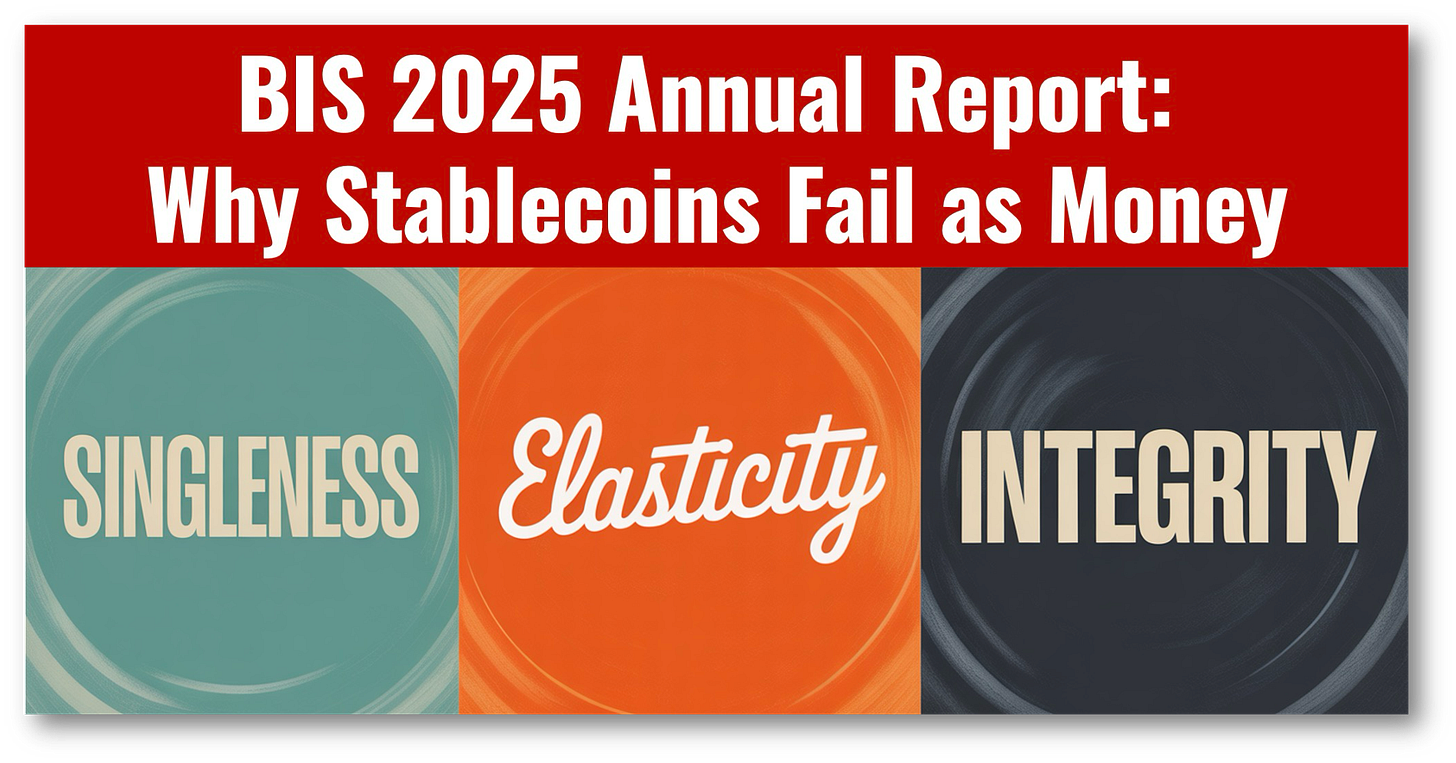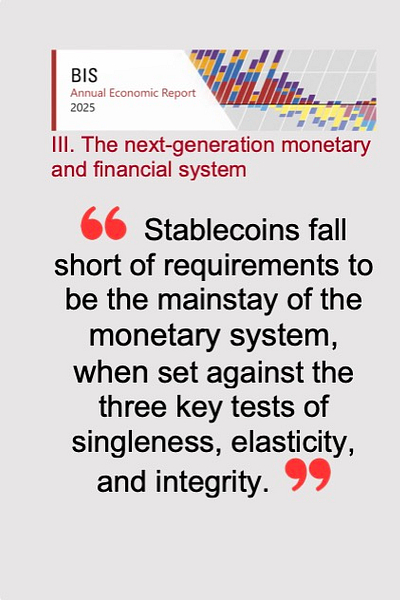BIS 2025 Annual Report: Why Stablecoins Fail as Money
The BIS should remember that "Perfect is the enemy of good."
This is my daily post. I write daily but send my newsletter to your email only on Sundays. Go HERE to see my past newsletters.
HAND-CURATED FOR YOU
The BIS’s 2025 Annual Report hammers stablecoins, declaring that they: “do not stack up well against the three desirable characteristics of sound monetary arrangements and thus cannot be the mainstay of the future monetary system."
The BIS’s proclamation will be met with varying degrees of credibility. Traditional bankers, you’ll say, “I told you so,” while crypto bros will declare once again that “the BIS is too old and clueless.”
Is the BIS correct?
Yes, they are inasmuch as they say that stablecoins aren’t suited to being the “mainstay” of the future monetary system. “Mainstay” is too high a bar.
What the BIS misses is that stablecoins are not intended to replace central bank money in totality, and that even with their admitted defects, they can be tremendously useful.
So what are singleness, elasticity, and integrity, which are the root of the BIS’s problem with stablecoins?
Singleness:
With singleness, money can be issued by different banks and accepted by all without hesitation. It does this because it is settled at par against a common safe asset (central bank reserves) provided by the central bank.
Breaking the singleness of money is, without question, stablecoins’ greatest weakness, and the BIS is correct to call it out. Stablecoins have private issuers and no central bank backing.
Simply put, without singleness, my stablecoin may not be worth as much as your stablecoin, even if both are dollar-based. Now, imagine a bank with 20 different stablecoins transferring millions in funds, and this problem goes from being an annoyance, as it is portrayed by crypto bros, to a disaster.
While solutions like the recently funded UBYX have been proposed to solve the singleness problem, it isn’t up and running yet.
Elasticity:
Stablecoin issuers’ balance sheets cannot be expanded at will, and any additional supply of stablecoins must be full funding by holders. This differs from banks, which can expand or contract their balance sheets through the use of central bank short-term credit.
This is best understood by example. In an RTGS instant settlement system, I may have an unpredicted bunch of large claims that require immediate settlement. With stablecoins, you either have the money or you don’t.
With bank deposits, central banks can provide them with short-term credit, allowing the bank a measure of “elasticity” in payments, a critical feature for the monetary system, no doubt.
Here, the BIS is reaching a bit. Elasticity is critical if we wish to categorize stablecoins as a “mainstay,” but for many other payment functions, this elasticity is not vital. So stablecoins can still be useful in areas that do not require this function.
Integrity:
Stablecoins have significant shortcomings when it comes to promoting the integrity of the monetary system. As digital bearer instruments on borderless public blockchains, stablecoins have been the go-to choice for illicit use to bypass integrity safeguards. The pseudonymity of public blockchains, where individual users’ identities are hidden behind addresses, can preserve privacy but also facilitate illegal use.
Yes, this is true, and the BIS is correct to call this out. Fraudsters’ use of stablecoins is the stuff of legend. While KYC/AML is required at the exchange, the coins may be sent to holders far removed from the KYC/AML chain, even if they end up back where they started. Will stablecoins clean up their act? We don’t know!
“Perfect is the Enemy of Good”
So if stablecoins aren’t the future of money, what is? The BIS promotes the concept of a “unified ledger” using “tokenised central bank reserves [CBDCs], commercial bank money, and government bonds.
The pursuit of a unified ledger, that is all-seeing and all-knowing, is in keeping with the BIS’s “Project Agora,” which is now trying to build such a system with the participation of 43 institutions.
It’s a massive project, and so far hasn’t reported significant progress, which, given its ambitious scale, shouldn’t be a surprise. For perspective, it makes the BIS’s mBridge CBDC project in Hong Kong look small by comparison.
The BIS is correct to point out stablecoin’s limitations, which have been widely overlooked in the frenzy surrounding the US’s GENIUS Act. Still, the question we all have to ask is, does the BIS have anything better?
The BIS would argue that the digital euro, a CBDC, is a superior product, and I agree. The problem is that the US rejects this solution out of hand, even going as far as to prohibit CBDC research. There will be no digital dollar CBDC, so the most expedient way to fill the immediate need for a digital dollar is stablecoins.
Stablecoins remind me of the old saying, “Perfect is the enemy of good.” Stablecoins are most certainly not perfect, but they can do good work for payments despite their problems.
🔴⚫️🔴⚫️🔴⚫️🔴⚫️🔴⚫️🔴⚫️🔴⚫️🔴⚫️🔴⚫️🔴⚫️🔴⚫️🔴⚫️🔴⚫️🔴⚫️🔴⚫️🔴⚫️🔴⚫️
The BIS does not like the stablecoin future envisioned by the US:
Society has a choice. The monetary system can transform into a next-generation system built on tried and tested foundations of trust and technologically superior, programmable infrastructures. Or society can re-learn the historical lessons about the limitations of unsound money, with real societal costs, by taking a detour involving private digital currencies that fail the triple test of singleness, elasticity, and integrity. Bold action by central banks and other public authorities can push the financial system along the right path, in partnership with the financial sector.






